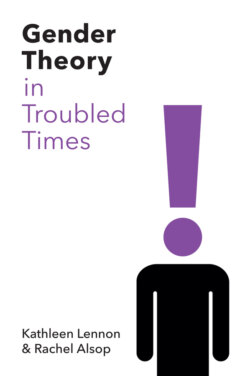Читать книгу Gender Theory in Troubled Times - Rachel Alsop - Страница 17
Sexed/gendered difference
ОглавлениеIn contemporary discussions of sexed differences, there is a renewed search for a determining factor which both divides us clearly into men and women and fixes the distinguishing features of each category. In favour again are sex hormones, particularly amounts of testosterone (Fine 2017). The other favourite contender is the brain (Rippon 2019). In many theories, the quantity of testosterone is thought to determine the development of the brain. With Fine and Rippon, we hope to challenge the assumptions informing such claims.
The concern of this book is to explain how we end up as sexed human beings, with self- and other-assigned categorizations as men or women, male or female (or trans men or women, or intersex, or non-binary), with which we may be happy or unhappy, but which, either way, is one of the defining features of both our subjectivity and our social positionality. As we noted in the introduction, this area of investigation is now termed ‘gender theory’, and the term ‘gender’ has come, in everyday usage, to signal such sexed positionality. Under discussion is the status of our categories of sexed difference – categories that may be marked by use of the terms ‘male’ or ‘female’ or ‘man’ and ‘woman’. There is a complexity here considering what terminology to use. ‘Male’ and ‘female’ are employed throughout the animal and, to some extent, plant kingdoms and so have more claim to be categories whose identifying criteria are fixed by biological science, criteria which may vary for different scientific purposes. But in everyday practice, for humans, we do not make a distinction between, for example, being female and being a woman. Here we are concerned with these categories as used in everyday interactions to characterize ourselves and others we encounter. What we are exploring is the (most common) binary division of people into male and female, a categorization which becomes fundamental to people’s sense of their identity, frames the way they are seen by others, and carries with it associated expectations of patterns of behaviour and social positionality. The division into male and female bodies, men and women, is linked in a complicated way to a division into masculine and feminine people – where masculinity is a set of psychological and behavioural traits that are considered particularly appropriate to those classified as male, and feminine traits appropriate to those classified as female. The link between being male and masculinity and being female and femininity is a normative one. It is what is supposed to happen but is often deviated from. And, indeed, there is never an absolute coincidence. In investigating how we end up as men and women, or as non-binary, we are therefore investigating a phenomenon that has bodily, psychological, behavioural and social dimensions. It also has mythical or imaginary ones. For we are surrounded by stories and images which convey meanings about what it is to be a woman or man which interact with the other strands of individuation. In this first chapter, we will be exploring the contribution made by what Beauvoir (see chapter 4) calls the data of biology.
In the introduction we introduced the notion of gender essentialism, the suggestion that there is some fixed set of conditions which determine whether we are male or female, men or women. Those who adopt gender essentialist positions most commonly anchor them in biology. It is assumed that biology will provide us with the answer to the questions of what determines whether a person is male or female, man or woman, or maybe some combination of both. In this book we resist the claim that biology is determining in this way. But to resist this claim is not to make our biological bodies irrelevant to the complex story of how we end up gendered. They are part of the picture but not the whole of it. Moreover, our biological bodies are themselves infinitely complex, open and changing, susceptible to multiple understandings, and interwoven with our wider material and social environments in ways that render it impossible to isolate the contributions they make from other aspects of our becomings (Rippon 2019).
